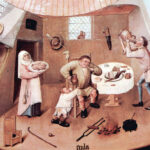21 May 1108: Archbishop Gerald of York dies reading Roman astrology
Ranulf Higden and John Trevisa. 1865. Polychronicon Ranulphi Higden monachi Cestrensis, Vol. 7. Ed. Joseph Rawson Lumby. London: Longman. Get it:
.Excerpt
Thomas, Archbishop of York, having died this year, Gerald succeeded him: a man, as rumour has it, subject to licentiousness, lust and malice. For, under his pillow, when he was died in a pleasure garden, was found a book of curious arts, Julius Firmicus, which he read in secret and in the noon hours. Wherefore the clerics of his church would scarcely allow him to be buried under the grass of heaven outside the church.
Comment
Comment
John Trevisa’s “a lecherous man, a witch, an evil doer” strikes me as deliberate mistranslation. My “grass of heaven” can’t be quite right, or else the Spanish would have coined “césped del cielo.” Wikipedia says that he died at Southwell, and that
His canons refused to allow his burial within his cathedral, but their hostility probably owed more to Gerard’s attempts to reform their lifestyle than to his alleged interest in sorcery. Gerard was at first buried beside the porch at York Minster, but his successor, Thomas, moved the remains inside the cathedral church.
Something to say? Get in touch
Original
Mortuo hoc anno Thoma Eboracensi episcopo, successit Gyraldus, vir quidem, ut fert rumor, licentiae, libidini et malificiis obnoxius. Sub ejus nempe pulvillo cum in viridario quodam decederet inventus est codex curiosarum artium videlicet, Julius Firmicus, quem secreto et meridianis horis lectitabat; quamobrem clerici ecclesiae suae eum sub coeli cespite extra ecclesiam vix sepeliri permiserunt.
56 words.
Similar
 22 September 1465: A menu for the enthronement at Cawood Castle of George Neville as Archbishop of York
22 September 1465: A menu for the enthronement at Cawood Castle of George Neville as Archbishop of York 26 December 1570: Edmund Grindal, Puritan archbishop of York, orders the removal of rood-lofts (and their superstitious images), and the erection of pulpits
26 December 1570: Edmund Grindal, Puritan archbishop of York, orders the removal of rood-lofts (and their superstitious images), and the erection of pulpits 12 April 0627: In a triumph for his Kentish wife, Edwin of Northumbria is baptised on Easter Sunday by Paulinus, in the latter’s wooden oratory on the site of York Minster
12 April 0627: In a triumph for his Kentish wife, Edwin of Northumbria is baptised on Easter Sunday by Paulinus, in the latter’s wooden oratory on the site of York MinsterSearch
Donate
Music & books
Place-People-Play: Childcare (and the Kazookestra) on the Headingley/Weetwood borders next to Meanwood Park.
Music from and about Yorkshire by Leeds's Singing Organ-Grinder.


 Bluesky
Bluesky Extwitter
Extwitter